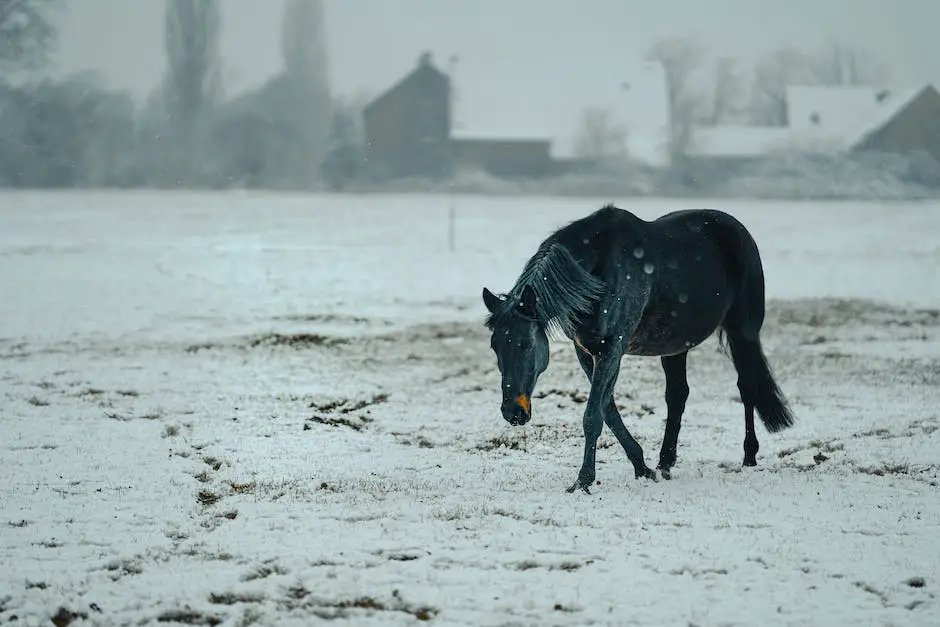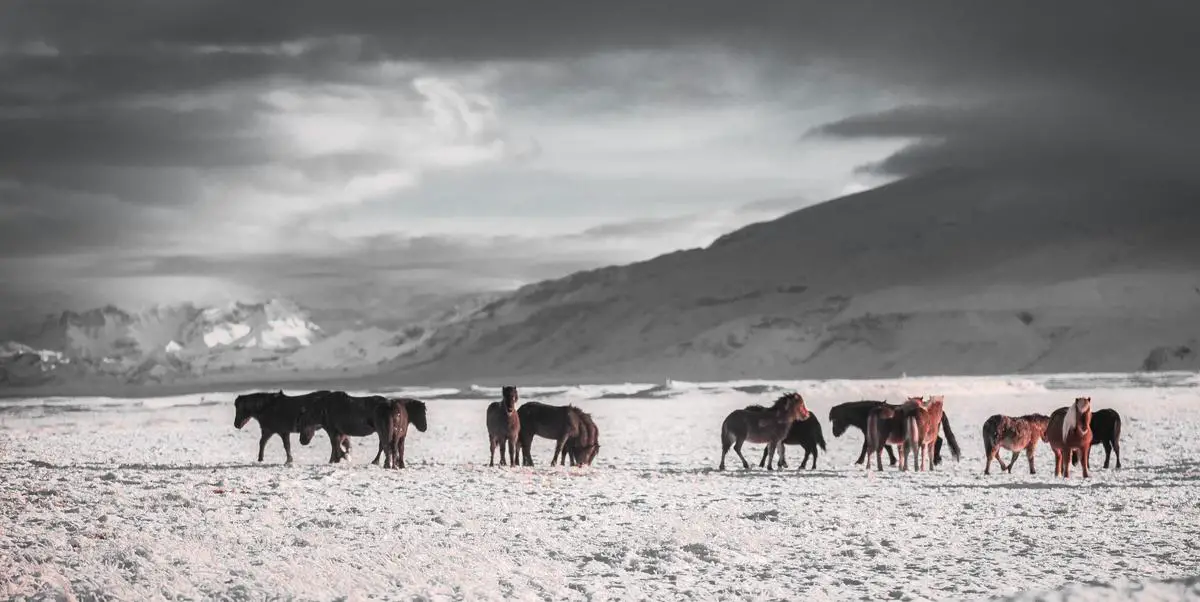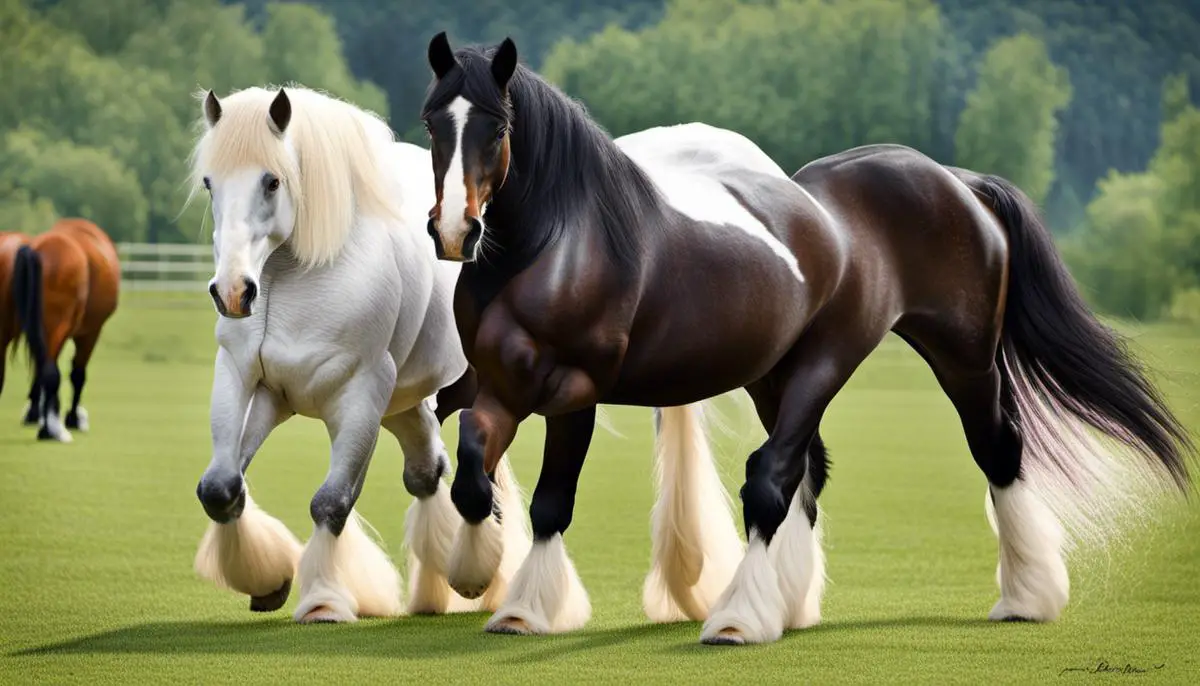Enveloping the majesty, power, and grace of horses, this essay ventures into a captivating journey to better understand two prominent categories of horses – the Shire Horses and the Draft Horses. While gaining an insight into their origins, physical characteristics, temperaments, and common functionalities, we shall seek to unveil the nuances that make each breed unique. Furthermore, we will endeavor to decipher the distinctive features of Shire and Draft horses, shape comprehensive comparisons between them, and grapple with the unique challenges posed by their respective caring and maintenance needs. The intention is to offer an inclusive perspective into these magnificent creatures, thereby equipping readers with the necessary knowledge to distinctively understand, appreciate, and care for these resilient breeds.
Table of Contents (Horspedia)
Understanding Shire Horses
Understanding Shire Horses: Origins and Background
The Shire horse is an English draft breed that traces its origins back to the “Great Horse” carried into battle by English knights during the middle Ages. Over time, Shire horses were selectively bred for agriculture and pulling heavy loads making them a popular choice for workforces around the world.
Physical Characteristics of Shire Horses
Renowned for their immense size, Shire horses are one of the tallest and most powerful horse breeds in the world. An adult male can stand up to 17 hands (68 inches or 173 cm) tall and can weigh up to 2200 lbs (1000 kg). They have a large, well-muscled body with broad, deep chest and powerful hindquarters. Shires have a characteristic long, flowing mane and tail, and distinctive feathering on the lower legs. Their coat can be black, brown, bay, or grey.
Temperament and Behavior of Shire Horses
Despite their enormous size, Shire horses are known for their tranquil and good-natured temperament. They are intelligent, willing, and adaptable, making them easy to manage and train. They are generally quiet, friendly, and exhibit a steady, patient demeanor.
Common Uses and Versatility of Shire Horses
In the past, Shire horses were primarily utilized for pulling heavy loads in rural, industrial and urban work. They also played a monumental role in agriculture, used for plowing fields and pulling wagons. Today, Shire horses are often seen at equine exhibitions, in horse pulling competitions, and as drum horses for ceremonial purposes in the British military. There has also been a resurgence in using them for logging and farm work because of their strength and minimal impact on the environment. They can also be ridden, although their size may make them suitable only for larger riders.
Misconceptions and Popularity
One common misconception is that all large draft horses are Shire horses. While Shire horses are a type of draft horse, not all draft horses are Shires. The term ‘draft horse’ refers to any breed that is bred to perform heavy, pulling tasks. Shire horses are simply one breed within this group.
The popularity of Shire horses stems from their strength and versatility, as well as their surprisingly gentle and calm attitude. Despite their declining numbers in the mid-20th century due to mechanization, Shire horses have witnessed a resurgence in popularity in recent years for both work and show.
Shire Horses vs. Other Draft Horses
When comparing Shire horses with other draft horse breeds, there are distinct differences to be noted. While all draft breeds exhibit extraordinary strength and a typically calm disposition, each breed has unique characteristics. For example, Belgian draft horses tend to be stockier with a lighter coat color than the Shire. Clydesdales, another popular draft breed, are generally not as tall as Shire horses and are often recognized by their characteristic high stepping gait. Percherons, originally bred in France, are renowned for their intelligence and willingness to work.
To summarize, the Shire horse, a prime example of a draft breed, possesses a remarkable combination of strength, pleasant disposition, and striking appearance. Whether serving in heavy labor, as a riding companion or in ceremonial roles, this type of horse exemplifies the perfect blend of power and grace.

Insight Into Draft Horses
Exploring Draft Horses Further
Extending beyond the Shire horse breed, Draft horses, or ‘Draught’, as referred to in the UK, have a rich history reaching back to medieval times. These large and muscular breeds are celebrated for their capacity to pull substantial loads, such as farming equipment or wagons. Although all draft horses were bred for their strength and size, each breed within this class boasts its unique characteristics in size, color, and temperament, ensuing a splendid diversity within this category of equine breeds.
Different Breeds of Draft Horses
Among the many breeds of draft horses, the Belgian, Clydesdale, Shire, and Percheron draft horses are particularly remarkable. The Belgian Draft Horse, as the name suggests, originated in Belgium and is known for its extraordinary strength and short but broad body. It is generally chestnut or roan in color.
Clydesdales, originated in Scotland, are famous for their elegance and animated gait. They are characterized by the feathering, or long hairs, on their lower legs and typically boast a bay coat with white markings.
Percheron horses are from France, and with their compact build and typically gray or black coats, they have a strong presence. Staying hardworking and easygoing, Percherons are recognized as versatile draft horses for both field work and transportation purposes.
The Shire Horse: A Unique Draft Horse
Among the aforementioned draft breeds, Shire horses stand out as a definitive subgroup. Originating from England, they are the tallest of draft horses, often standing over 17 hands (68 inches) at the withers. With their feathered legs, large hooves, and powerful build, Shire horses are readily identifiable. Traditionally, black, bay, or gray are the most common coat colors found in Shire horses.
Shire horses, once used for farming and cart-pulling, were essential to England’s early industrial revolution. Today, they are primarily used for promotional and ceremonial purposes, but they also excel in pulling competitions and other equine sports.
Comparing Shire Horses and the Rest of the Draft Horses
When it comes to differences within the scope of draft horses, factors such as origins, physical attributes, and traditional uses play a significant role. Shire horses, known for their colossal size and steady temperament, are noteworthy. They share many traits with other draft horses, such as substantial muscle mass, slow trot, and a calm demeanor ideal for pulling heavy loads; but their unique height sets them apart. Despite these subtle differences, all draft horses share a common heritage as indispensable workers and companions for human beings throughout history.
The Modern Role of Draft Horses
As technological advancements in mechanization took over labor-intensive tasks, the agricultural and transportation use of draft horses considerably lessened. Today, they serve primarily where machinery is not feasible or absent, such as in forest logging, or in specific competitive and recreational events. Among these draft horses are the Shire horses. Despite their diminished traditional roles, these towering and strong equines captivate enthusiasts worldwide with their majestic size and kindly disposition. These horses embody remnants of our agricultural history and continue to play valuable roles in working farms and rural tourism globally.

Photo by martinjernberg on Unsplash
Comparing Traits and Uses
Shire Horses: The Gentle Giants of the Draft Breed
Hailing from England, Shire horses stand out as one of the world’s largest and most powerful horse breeds. Males stand an impressive 17 to 19 hands (with 1 hand equalling 4 inches) tall, while their female counterparts typically measure around 16 hands. Characteristic features of the Shire horse include a solid and muscular physique, broad chest, and a weight range between 1800 and 2400 pounds. Notable physical characteristics include long, feathery hair on their lower legs, oversized hooves, and coloration typically in black, bay, or grey.
In terms of temperament, Shire horses are recognized for their peaceful and manageable nature. Despite their imposing dimensions, they are known to be gentle and easy to control, making them fitting for a variety of equestrian pursuits. Historically used as war horses for their strength and stamina, these days they are commonly used in farming, forestry, and promotional activities, attributed to their striking appearance and amiable disposition.
Draft Horses: Versatile Powerhouses of Labor
The term “draft horse” covers various heavy, muscular breeds designed for hard, heavy tasks, such as plowing or cart pulling. This category includes not only the Shire but also other big breeds like the Belgian, Clydesdale, Percheron, and Suffolk Punch. Their sizes can vary but generally fall within the range of the Shire, at about 16 to 19 hands. The weight of a draft horse can range from 1600 to 2400 pounds, depending on the breed.
Draft horses, like Shire horses, are appreciated for their gentle and patient personalities. They are intelligent and trainable, making them suitable for a variety of uses beyond sheer labor. Historically, these horses have played integral roles in agriculture, industrial transportation, and wartime efforts. Today, draft horses are still utilized in farming and forestry, as well as Therapeutic Riding programs and various equestrian competitions.
Comparing Shire Horses and Draft Horses: Two Peas in a Hearty Pod
Although Shire horses fall under the broader category of draft horses, there are visible distinctions between the Shire breed and other draft breeds. Shire horses tend to be among the tallest and heaviest, with distinctive feathering on their legs. However, in terms of behavior, both Shire and other draft horses share similar characteristics, including their docile nature, intelligence, and trainability.
As for working applications, both types excel at heavy-duty tasks due to their strength and endurance. Their calm temperament also makes them suitable for roles that involve interaction with people, such as promotional functions or therapeutic riding sessions. It’s important to note that the suitability of a certain breed for a particular task depends on the individual horse’s training and conditioning, in addition to its inherent physical and behavioral traits.
In summary, both Shire Horse and other Draft horses possess distinct attributes that set them apart, but they also share some integral characteristics. These traits, ranging from their considerable strength to their majestic stature, make them beloved companions in a number of settings, not least of which are agricultural operations and therapeutic programs.

Caring & Maintenance Needs
Nutritional Needs: Comparing the Shire Horse and Draft Horse
Both Shire and Draft horses require a nutrient-rich diet centered on hay, oats, corn, barley, and plenty of fresh water, which supports their physical strength and stamina. However, the Shire horse, famed as one of the most massive horse breeds, requires a more extensive feeding program. Their larger physique coupled with their naturally robust work ethic necessitates a higher caloric intake. Consequently, caring for a Shire horse often incurs higher feeding costs relative to other Draft horses.
Grooming Needs: Shire Horse vs. Draft Horse
Graft horses generally have less complicated grooming needs than Shire horses. A Draft horse’s shorter hair and smoother coat means they require basic brushing and hoof cleaning regularly. Shire horses, on the other hand, have long, silky hair called “feathers” around their hooves which require more intensive care to keep clean and free from pests. This often requires more tools and time, potentially adding to the upkeep costs.
Exercise Schedules: Shire Horse vs. Draft Horse
Exercise is essential for all horse breeds. Both Draft and Shire horses need regular exercise to maintain their health and fitness. As working horses historically used for tasks like plowing, hauling, and other heavy tasks, both breeds respond well to a structured exercise regimen. However, the Shire’s larger frame means that they may need slightly more exercise to maintain muscle tone and joint health compared to the standard draft horse.
Physical Care and Health Issues: Shire Horse vs. Draft Horse
Health-wise, both Draft and Shire horses are generally strong breeds. However, due to its larger size, the Shire horse can be more susceptible to certain health issues. Problems such as Chronic Progressive Lymphedema (CPL) that affects the legs, or difficulties with their digestive system, can be more common and need ongoing care and possibly vet attention. Draft horses, while also susceptible to these issues, do not face them as commonly as Shire horses, potentially reducing vet fees and healthcare costs.
Expenses for Upkeep: Shire Horse vs. Draft Horse
While the cost of maintaining any horse can be substantial, the upkeep and maintenance costs for a Shire horse can be significantly higher than that of a typical Draft horse. This is due to the Shire’s larger size needing more food, the potential for more veterinary care, and the additional time spent on grooming due to their unique feathered hooves. It is also worth mentioning that the purchase price for a Shire horse is usually higher than most draft horse breeds.
In summary, while both breeds require a significant level of care, maintaining a Shire horse can be more demanding in terms of time, effort and money compared to the average Draft horse. Your choice between the two breeds should take these considerations into account, as well as the specific needs and capabilities of the individual horse.

Whether it is a majestic Shire horse, with its superior strength and gentle temperament, or any one of the diverse breeds of Draft horses – each markedly unique in its characteristics, both categories provide great value to their owners and animal lovers alike. It becomes evident that selecting a horse from either category primarily revolves around the needs and expectations of the individual. Care and maintenance play vital roles in ensuring these horses remain at their best, regardless of their inherent genetic traits. Through this discourse, it is hoped that readers find themselves richly informed, having discovered new realms of knowledge regarding these amazing horse breeds. Just as these horses have evolved over centuries to suit our needs and desires, may our understanding of them continue to deepen, leading to their better care, preservation, and appreciation.